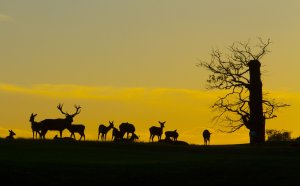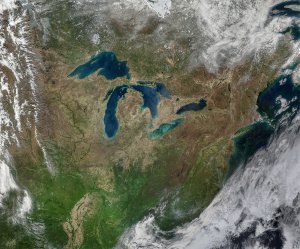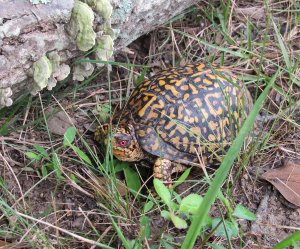Wildlife ranges are shifting north in search of habitable climates.
September 27, 2023
Ali Groulx, interpreter
Imagine that you are living in a house with three stories: a basement, a main floor, and an upstairs. The main floor is 70°F. You turn on the oven to prepare for dinner, and the main floor of the house starts to become uncomfortably hot. You try to turn off the oven… but unfortunately for you, the oven has broken and will only continue to get hotter. As you are sweating and panting, you decide to relocate to a different floor – the basement. Knowing that heat rises, you decide it is best to descend the creaky steps. The cool air is refreshing, but suddenly, the basement begins to flood. As the water rises to your knees, you decide to retreat to the main floor. At this point, the oven has made the temperature soar to 100°F. You attempt to leave through the front door, but the flood has pinned it shut. Without any other option, you ascend the steps to the second floor, assuming it will be unbearable. Although… what is that? You feel a cool, gentle breeze lap over your face. Lucky for you, someone left the window open and a fan on. The otherwise unbearable heat of the second floor has been mitigated, allowing you to enjoy a peaceful rest while you try to figure out how to fix the oven and your underwater basement…
As the climate in Michigan warms, our flora and fauna respond much like we did in the scenario above. Although some species like oaks, maples, and hickories are expected to continue to thrive in a warmer Michigan, that is not the case for all species. Regardless, the temperature is a hard line; even if the habitat is perfect, even if food is available, if the temperature change is vast enough, most species will be affected. The flora and fauna in Michigan are relatively ‘new,’ considering the geological history of our state. When massive sheets of ice covered the Great Lakes basin some 20,000 years ago, animals who could not adapt to the natural climatic shift retreated to refugia, or suitable habitats, to the west and the south. As glaciers began to slowly retreat over the next 10,000 years, species began to reestablish themselves as occupants as they returned to the land uncovered. Still, it took thousands of years for life to transform into the collection of flora and fauna we recognize today.

In the study of phenology, scientists examine the relationships between climate and periodic biological phenomena, such as migration and plant flowering. Anthropological climate change, or rather climate change driven by humans, has substantially altered the timeline of many biological processes that have historically morphed slowly. In our three-story house scenario, you did not predict that your oven would make the temperature unbearable so quickly. When you adjusted by moving elsewhere, again you did not predict that your basement would flood… because why would you? In nature, species depend on the predictable ecological processes the Earth goes through. When growing seasons are extended, or there is an early spring, the historic phenology, or timeline, is thrown off. This can confuse species of plants and animals, causing them to not behave as expected.

If all the land in the world had stayed as one big interconnected mass, a la Pangea, most species would be able to shift their ranges north, provided they could keep up with the warmer climate shift. But, as we know, the existence of Michigan is a unique geographical feature. With water surrounding all but the southern LP border and the western UP border, our state serves as a place of refugia for non-Michigan native species in search of habitable land. As the climate warms, certain species may see an increase in northern populations as their southern range depletes. For instance, it is predicted that the box turtle will thrive in a warmer Michigan even though their global outlook is poor. Box turtles are not very tolerant of extreme weather shifts, but they do well in a moderate climate. They prefer disturbed marshlands, meadows with small shrubs, and open woodlands.

However, there are still factors today that could prevent this population increase. Box turtles are negatively affected when their habitats are fragmented by roads or left to overgrow. Without careful mitigation and selective habitat preservation, the many vulnerable species that currently reside in Michigan could be negatively impacted. Michigan’s terrestrial species are limited by the boundaries of the Great Lakes. There are positives to being surrounded by freshwater, though. Flora and fauna seeking a cooler environment could relocate closer to the coasts. In our scenario, when we relocated to the second floor, we were relieved that the hot temperature was quelled by a fan and an open window. The wind off the Great Lakes waters would have a similar cooling effect. Habitat management for species shifting north may make up for lost habitats in the south, but still, humans must encourage and assist the native species here. After all, human activity has contributed to the rapid climate shifts we are experiencing today.
Changes in land use due to climate change mitigation, such as sustainable energy, should not be overlooked. Newer land uses including the creation of wind farms, solar farms, and mass crop plantings for biofuel require proper planning and risk assessment. Crop monocultures can strip once fertile soil of its nutrients, and the conversion of wetlands to dryer fields contributes to habitat loss. These present and future land changes will have an impact on wildlife. Shifting to sustainable energy production that emits less carbon into the atmosphere is beneficial, but alas, the likelihood of uncertainty is prevailing when it comes to climate change. Any degree of climate warming will influence local and global populations. Thankfully, scientists use a wide variety of factors and scenarios to determine a species climate resiliency. In the meantime, we can do our part by continuing to create a hospitable environment for our native Michigan species to thrive for the years to come.
